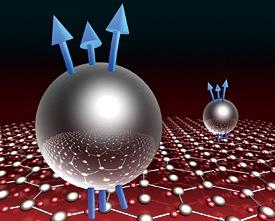

11/29/2010

© 2010 M. Kawasaki
Two-dimensional systems confine electrons to a single plane, and in doing so produce a whole host of intriguing electrical phenomena. Masashi Kawasaki from the WPI-AIMR at Tohoku University and co-workers from a variety of other institutions in Japan have now observed one such effect — the fractional quantum Hall effect — in an oxide material1.
The generation of quantum transport phenomena requires extremely smooth interfaces because such systems are necessarily thin and therefore highly sensitive to any imperfections or roughness. As oxide surfaces have a tendency to be quite rough, achieving such quantum phenomena in oxide systems is particularly difficult.
Kawasaki and his team used a technique known as molecular-beam epitaxy to slowly deposit a 300 nanometer-thick layer of magnesium-doped zinc oxide onto zinc oxide without introducing any impurities. The electron mobility, a measure of how quickly electrons can move under an electric field, of their ultraflat film was six times higher than that achieved previously for oxides. “We made zinc oxide that is as clean as advanced semiconductors so that electrons can move without scattering,” explains Kawasaki.
The fractional quantum Hall effect arises because of the collective behavior of the electrons confined in a two-dimensional system. The electrons behave as if they are a composite particle composed of an electron and three magnetic-flux quanta (Fig. 1). The tell-tale signature of this behavior is that the Hall resistance of the material — the transverse electrical resistance in the two-dimensional plane — jumps in discrete steps as the field is increased. These steps appear at values equal to the ‘von Klitzing’ constant divided by either an integer or a fraction.
Integer steps, which have been seen in oxides before, are the result of different, and somewhat simpler, underlying physics, producing what is known as the integer quantum Hall effect. The high quality of the thin film produced by Kawasaki and his team has enabled the observation of fractional steps in an oxide for the first time.
The fractional quantum Hall effect has already been seen in other materials such as silicon and gallium arsenide, but Kawasaki hopes that such clean zinc oxide films might soon enable the observation of a new effect. “Electrons in zinc oxide behave as though they are heavier than those in silicon or gallium arsenide. The heavier the electrons are, the more they repulse each other, and this makes the correlation effects more pronounced. It might enable the creation of even-denominator states such as 5/2, which could be used for quantum computation.”
Tsukazaki, A., Akasaka, S., Nakahara, K., Ohno, Y., Ohno, H., Maryenko, D., Ohtomo, A. & Kawasaki, M. Observation of the fractional quantum Hall effect in an oxide. Nature Materials 9, 889–893 (2010). | article
This research highlight has been approved by the authors of the original article and all information and data contained within has been provided by said authors.